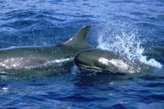False Killer Whale (Pseudorca crassidens)
Status | Taxonomy | Species Description | Habitat | Distribution |
Population Trends | Threats | Conservation Efforts | Regulatory Overview |
Key Documents | More Info
Status
MMPA - False killer whales, like all marine mammals, are protected under the MMPA.
Taxonomy
Kingdom: Animalia
Phylum: Chordata
Class: Mammalia
Order: Cetacea
Family: Delphinidae
Genus: Pseudorca
Species: crassidens
Species Description
False killer whales are large members of the dolphin family. Females reach lengths of 15 feet (4.5 m), while males are almost 20 feet (6 m). In adulthood, false killer whales can weigh approximately 1500 pounds (700 kg).
They have a small conical head without a beak. Their dorsal fin is tall and their flippers (pectoral fins) have a distinctive hump or bulge in the middle of the front edge. False killer whales have dark coloration except for some lighter patches near the throat and middle chest. Their body shape is more slender than other large delphinids.
False killer whales' breeding season lasts several months. Gestation periods range from 14 to 16 months and lactation occurs for one and a half to two years. False killer whales have low reproduction rates with calving intervals of approximately seven years. Maturity occurs at around 12 years of age and maximum longevity is 63 years.
These whales are gregarious and form strong social bonds. They are usually found in groups of ten to twenty that belong to much larger groups of up to 40 individuals in Hawai'i and 100 individuals elsewhere. They are known to "strand" in large groups as well. False killers are also found with other cetaceans, most notably bottlenose dolphins. To increase success of finding prey, these whales travel in a broad band that can be up to several miles wide.
Food sharing has been documented between individual false killer whales. They feed during the day and at night on fishes and cephalopods, and they are known to attack smaller dolphins that are involved in the tuna purse-seine fishery in the Pacific Ocean.
Habitat
They prefer tropical to temperate waters that are deeper than 3,300 feet (1000 m).
 False Killer Whale Range Map (click for larger view PDF) |
Distribution
False killer whales occur in the U.S. in Hawaii, along the entire West Coast, and from the Mid-Atlantic coastal states south. The species can also be found in all tropical and temperate oceans worldwide.
Population Trends
Currently, the Hawaii stock is estimated at 270 whales and the Northern Gulf of Mexico stock at 1040 whales. There are not enough data to estimate population trends for these stocks. See below for links to the most recent stock assessments for the U.S. populations.
Threats
False killer whales are taken as bycatch or interact with a number of fisheries, such as the Hawaii Longline fishery and bottomfish fishery off the Northwestern Hawaiian Islands. They are also hunted and killed opportunistically in Indonesia, Japan, and the West Indies.
Conservation Efforts
False killer whales are classified as Lower Risk - Conservation Dependent on the IUCN Redlist ![]() . NMFS funds several research studies
. NMFS funds several research studies ![]() on life history and stock structure of false killer whales in Hawaii.
on life history and stock structure of false killer whales in Hawaii.
Regulatory Overview
This species is protected under the Marine Mammal Protection Act of 1972 as amended.
Key Documents
(All documents are in PDF format.)
| Title | Federal Register | Date |
|---|---|---|
| Stock Assessment Reports | n/a | various |
